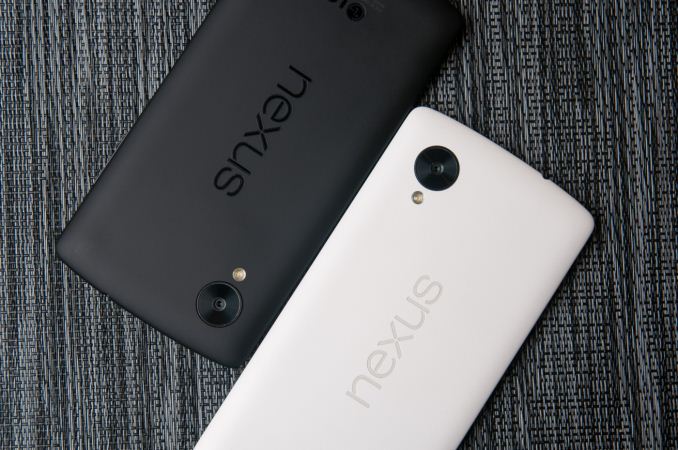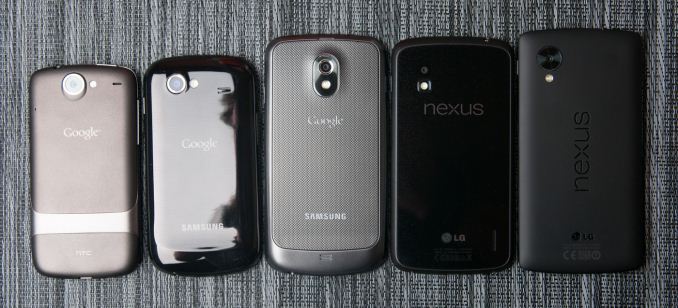Google Nexus 5 Review
by Brian Klug on December 5, 2013 8:00 AM EST- Posted in
- Smartphones
- LG
- Android
- Mobile
- Snapdragon 800
- Android 4.4
- Nexus 5
As is often the case, the conclusion to this Nexus review is one part software, and one part hardware. I'll start with a discussion of Android 4.4.
Google adds a subtle but appreciated level of polish to the Android UI with its latest iteration of the OS. This has been true for a while now, but the Android we're talking about today is really a far departure from what existed back in the early 2.x days. Anyone who hesitated to move from iOS back then will find themselves with an OS today that is clearly a substitute good. What once was an OS that only appealed to a crowd that appreciated its flexibility is now just as approachable as anything else on the market, and just as powerful as it always has been.
Likewise, Android is now smoother than before thanks to further improvements brought forth by project butter and refinements to the GPU-accelerated 2D rendering pipeline that was introduced in Android 3.x Honeycomb. Like any platform, it's still possible to craft apps that jank, but you have to look hard for examples that truly drag the experience down, and on the whole almost all the system apps are polished and performant. Project svelte also reduces memory footprint for midrange (emerging market) devices with 512 MB of RAM, where most of the remaining growth is for the smartphone market abroad and at home. I can't wait to see how that bears itself out even on devices like the Moto G with 1 GB of RAM or less, since it's hard to immediately find the difference on flagships with 2 GB or more that aren't always under high memory pressure.
I'm glad to see the antiquated SMS/Messaging app gone, but I'm puzzled by the poor integration into Google's new Hangouts app. The Hangouts experience in Android remains incredible, but the SMS component is far from the sort of seamless integration I had hoped for.
The most disappointing part about Android 4.4 is the miserable camera UI, but I'll get to its impact on the Nexus 5 in a moment.
For the price, the Nexus 5 is easily one of the best buys on the market today. At $349 you not only get the absolute latest hardware, but the most accurate 1080p display available on an Android device. I really can't give Google enough credit here for doing what literally no other Android OEM seems to care enough about and actually shipping a display with proper sRGB coverage. It's not quite as good as what you'll get from a 2013 Nexus 7, but it's easily the best I've ever encountered in all of my experience with Android devices.
It's good to see the default storage capacity move from 8GB to 16GB, but I would really like to see Google embrace even larger options. There's no reason Google couldn't offer a 64GB Nexus 5, and/or be a little aggressive on NAND sourcing and push for a 128GB model as well.
The fact that the Nexus 5 ships unlocked at its price point is another huge selling point. It seems to me that what you can get for $179, $349 and $599 is improving substantially across the market. I would love to see Google extend the Nexus family both up and down the pricing spectrum to really provide excellent solutions for all segments of the market.
The camera story on the Nexus 5 is among the most frustrating aspects of this phone. From a hardware perspective, Google has settled on a combination of sensor and optics that's quite close to the most optimal configuration available today, and a dramatic improvement from the Nexus 4. The problem with the Nexus 5's camera is entirely limited to the horrible mess that is the default Android camera app. We're nearly into 2014 yet substantial shutter lag, focusing issues and a preview that doesn't reflect reality are still problems with the AOSP camera. The fact that many other Android OEMs have already worked around some if not all of these issues is hugely disappointing. Depending on how important the camera experience is to you will really determine whether or not the Nexus 5 is a good fit. Google has apparently told other publications that software fixes are on the way, but it's currently impossible to gauge the magnitude of improvement coming down the pipe.
Thankfully, we find ourselves in a time where there are a number of excellent options in the Android space.
Quite possibly the closest alternative to the Nexus 5, while still retaining the mostly-stock Android experience, is Motorola's Moto X. You lose out on core count and display resolution, but in return you get a smaller/more comfortable body, potential for color customization, and a far more usable camera today. The Moto X is just a much more polished device overall, and something you can also find on Verizon (not an option for Nexus 5). If having access to virtually-stock Android is of value to you and you want a cleaner experience today, the Moto X is a great alternative to the Nexus 5.
On the other end of the spectrum there's LG's G2 - the Nexus 5's closest hardware relative. Here you also get a much more functional camera offering and even better battery life. The tradeoff is of course that you lose the stock Android UI and the display isn't as accurate (it is however slightly larger), but it's absolutely a liveable option if you value things like a usable camera.
Google is really so close to perfecting the Nexus as a smartphone. Nexus 5 is a huge improvement over Nexus 4, and the obvious upgrade for Nexus 4 users, it just still needs a few refinements before I can comfortably recommend it to normal smartphone shoppers. For enthusiasts seeking the device that will get Android updates first, or shoppers looking for optimal value, the Nexus 5 is a definite buy.












231 Comments
View All Comments
Pr3ch34r - Thursday, December 5, 2013 - link
Not-everyone-buy-a-nexus-for-300-fucking-dollarsPr3ch34r - Thursday, December 5, 2013 - link
I think he hit the jackpotffh2303 - Thursday, December 5, 2013 - link
About the charging time,my unit [a black 32GB D820] charges in under 90 minutes using a 2A Note 2 charger [Samsung ETA-U90UWE] while on. Using the Battery Monitor Widget by 3c I observed that while idling on the homescreen the phone consumes around 450mA [shown as -445mA in the app] and when I plug in the Note 2 charger it shows the phone is charging at around 1500mA [shown as +1500mA]. My charging time with the stock LG charger is the same as your findings though.rxzlmn - Thursday, December 5, 2013 - link
I wonder why the reported times from the battery life benchmarks are so much higher than any of the reported screen-on times in 'real-world' usage? I am not trying to discredit the data, just honestly curious. How does one get close to 9 hours of constant screen-on time while the phone is being used, and why is there not a single battery stat from phones in use anywhere close to that number?On a side note, do you plan on reviewing the Sony Z1? I am asking because it has generally received mixed reviews in terms of battery life, but actually seems to perform very good in 'real life' scenarios.
sherlockwing - Thursday, December 5, 2013 - link
Anandtech is one of the few sites that set all phone to the same brightness(200nits) when battery testing. What you see from other websites is that they test every phone at their auto-brightness or max brightness setting. That's why Anandtech's battery life benchmark results are different from other sites.rxzlmn - Thursday, December 5, 2013 - link
I'm talking about real usage, i.e. people who own the phone post screenshots of Android battery usage stats. Not benchmarks. The best you see for the N5 is 5 hours+, even with WiFi only.sherlockwing - Thursday, December 5, 2013 - link
Ofc having the phone run benchmark is going to result differently than real life usage since the scenario is different.Cinnabuns - Thursday, December 5, 2013 - link
The tests performed here are controlled and I imagine that the phone is not being moved around a whole lot during battery-life testing (and it shouldn't be). However, one of the nicest things about having a smartphone are location-aware services. And they drain the battery. A lot.Unfortunately, one of the biggest culprits is Google's own location reporting service, which itself is integral to various Google Now features.
Of course, there are also various bugs that people in the real world encounter that are not triggered by the very specific test conditions in the battery life tests here. For example, Android 4.3 had a bug that could cause a phone to never "deep sleep" after wireless charging. But there's really no way for a review site to try to hunt down all the battery bugs and reproduce them. That's not really within scope of a battery life test and reviewers aren't paid to do QA on a phone, so they can only report on specific bugs they encounter in their personal use of the device (or bugs that are so heinously obvious that everybody has heard about already).
In short, there's no way a review site knows what YOUR "real-world" usage is. So the best thing they can do is to perform a controlled study with a published methodology and report the results. You get to interpret whether that methodology can be extrapolated to your own "real life" use. Sadly, other "review" sites somehow extrapolate their own unscientific experience as representative of real life usage when in truth, there is no universal real-lifeusage.
Impulses - Friday, December 6, 2013 - link
At the end of the day what matters most is that AT's testing is under controlled circumstances SMS repeatable, thus you get a very fair relative comparison between the tested phones. You may not get 9 hours on wifi if you aren't sitting next to the router, at X brightness, with zero background syncs, etc etc; but you can easily tell whether phone A will so better than phone B based on their tests. Isn't that all that really matters when you're trying to decide whether to buy A or B?Impulses - Friday, December 6, 2013 - link
SMS = andWTB comment edit